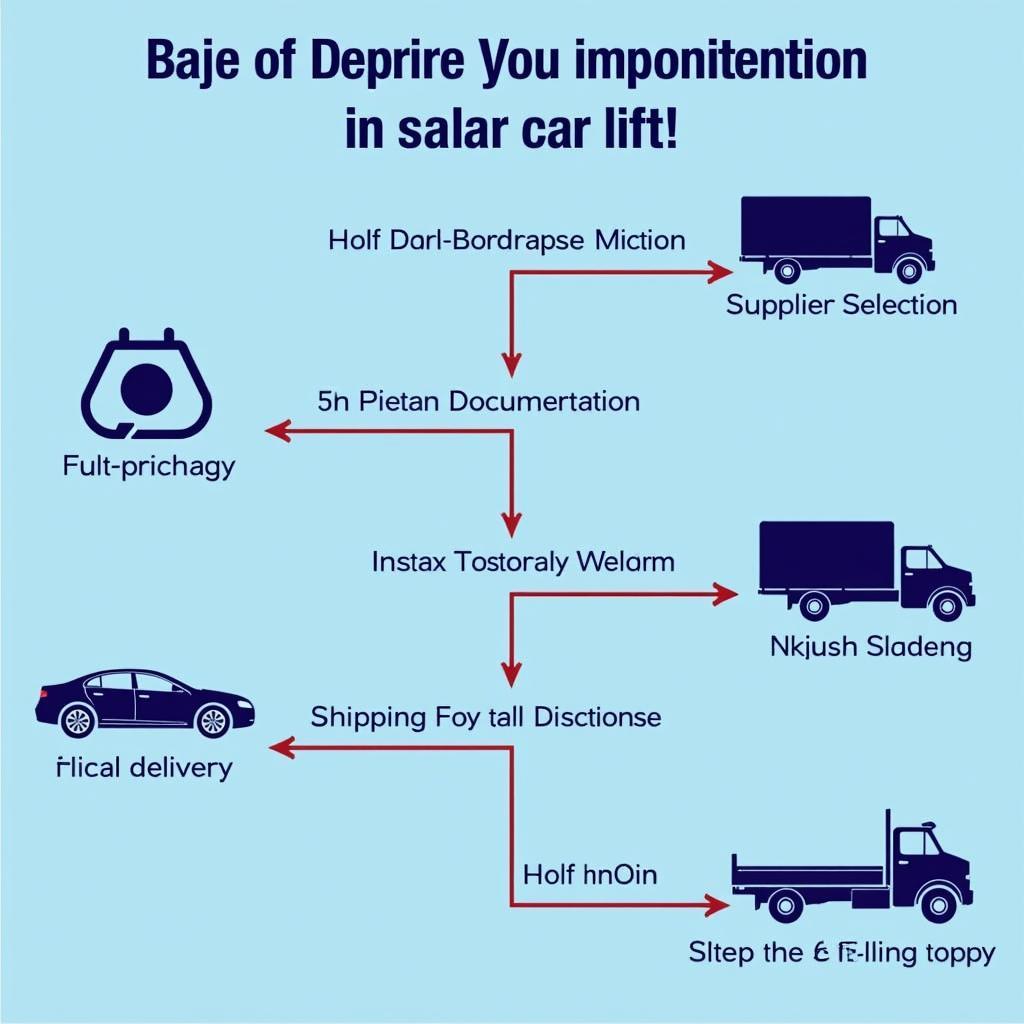Car Lift Import Procedure: A Comprehensive Guide
January 5, 2025Importing a car lift involves a specific procedure to ensure compliance with regulations and a smooth transaction. This guide provides a detailed overview of the car lift import process, covering everything from initial research to final delivery.
Understanding the Car Lift Import Process
Before diving into the specifics, it’s crucial to understand the overall process. Importing a car lift isn’t as simple as buying one locally. It requires careful planning, research, and adherence to specific regulations.  Flowchart illustrating the car lift import process This guide will break down each step, providing you with the necessary knowledge to navigate this process successfully.
Flowchart illustrating the car lift import process This guide will break down each step, providing you with the necessary knowledge to navigate this process successfully.
Finding the Right Supplier
Identifying a reputable supplier is paramount. Factors to consider include the supplier’s experience, product quality certifications (like CE or ASME), and after-sales service. Thorough research and due diligence are crucial in this stage. Don’t hesitate to request references and compare quotes from different suppliers. A reliable supplier can make the entire import process significantly smoother.
Navigating the Legal Landscape
Importing car lifts involves adhering to specific legal requirements and regulations. These regulations can vary depending on your country. Consult with a customs broker or legal expert to ensure you comply with all applicable rules. Understanding these regulations upfront can prevent delays and costly penalties.
Handling Logistics and Shipping
Shipping a car lift requires careful planning and coordination. You’ll need to determine the appropriate shipping method (sea freight, air freight), handle insurance, and manage customs clearance procedures. Working with a freight forwarder can simplify this complex process. They can handle the logistics, ensuring your car lift arrives safely and on time.
Ensuring Quality and Safety
Before finalizing the import, ensure the car lift meets all necessary safety and quality standards. This includes verifying certifications and conducting thorough inspections upon arrival. Remember, safety is paramount when dealing with heavy machinery like car lifts.
Post-Import Procedures
Once the car lift arrives, you’ll need to handle final inspections, installation, and any necessary permits or licenses. Ensure you have qualified professionals handle the installation to guarantee safety and proper functionality.
Cost Considerations
Importing a car lift involves various costs, including the purchase price, shipping, customs duties, taxes, and insurance. It’s crucial to factor in all these costs to accurately budget for the entire process.
Car Lift Import Procedure: FAQs
Here are some frequently asked questions about importing car lifts:
- What documents are required for importing a car lift? Typically, you’ll need a commercial invoice, packing list, certificate of origin, and bill of lading. Specific requirements may vary depending on your country.
- How long does the import process typically take? The timeframe can vary depending on several factors, including the supplier’s location, shipping method, and customs clearance procedures. It can range from a few weeks to several months.
- Do I need a customs broker? While not always mandatory, using a customs broker is highly recommended. They can navigate the complex customs regulations and ensure a smoother import process.
- What are the common shipping methods for car lifts? Sea freight and air freight are the most common methods. Sea freight is generally more cost-effective but slower, while air freight is faster but more expensive.
- What safety certifications should I look for? Look for certifications like CE (European Conformity) or ASME (American Society of Mechanical Engineers) to ensure the car lift meets international safety standards.
- What are the Incoterms I should be aware of? Understanding Incoterms (International Commercial Terms) is crucial for defining responsibilities and costs associated with shipping and delivery. Common Incoterms include FOB (Free on Board) and CIF (Cost, Insurance, and Freight).
- How do I find a reputable car lift supplier? Conduct thorough research, request references, and compare quotes from different suppliers. Look for suppliers with experience, certifications, and positive customer reviews.
Conclusion
Importing a car lift requires careful planning and execution. By following the outlined procedure and understanding the key considerations, you can successfully navigate the import process and acquire the equipment you need. Remember to prioritize quality, safety, and compliance with all applicable regulations. For further assistance, please contact us. Understanding the car lift import procedure is essential for a smooth and successful transaction.
For any assistance with your car lift import needs, please contact us at Phone Number: 0396443476, Email: [email protected] or visit our address at 23 Tháng 3, Đắk Nia, Gia Nghĩa, Đắk Nông, Việt Nam. We have a 24/7 customer support team ready to assist you. We also have articles about car lift maintenance and safety tips. Contact us today!